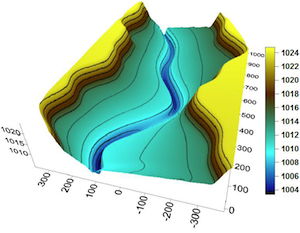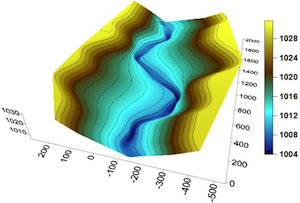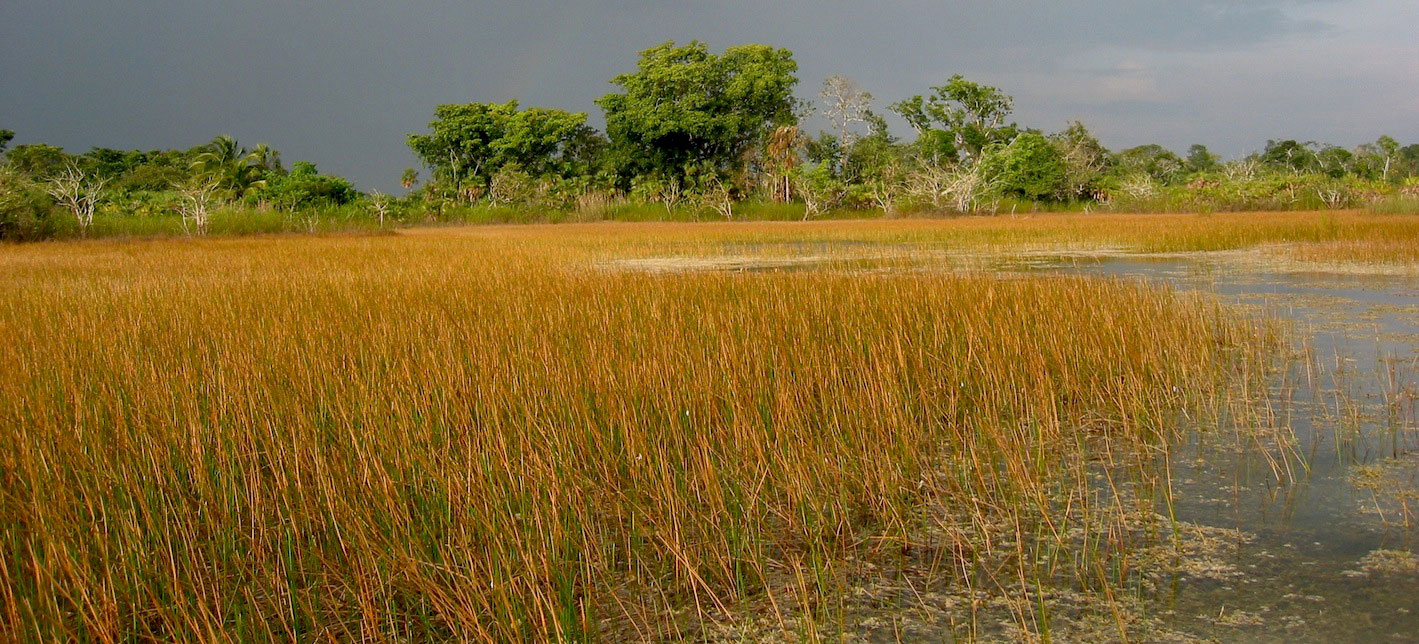Synthetic River Valleys
Participants
Gregory B. Pasternack, Rocko A. Brown, Belize A. lane, Rafaeli O. Arroyo
Superseded
This content has been superceded by development of River Builder, but there are some good ideas and content on this page, so it is saved to provide some background and historical ocntext to River Builder development.
Background
There are two phases of knowledge production: analysis and synthesis. During the analysis phase, scientists aim to explore nature and discern natural laws. Near-census river science is a state-of-the-art approach to analyzing natural rivers at this time. However, the history of science shows that scientists can end up satisfied with principles that are surprising crude with low explanatory power. Without being forced to put scientific knowledge to the test in real-world applications, there is not sufficient necessity and pressure to insure that scientific ideas are accurate and complete. That is why there needs to be a synthesis phase. During synthesis, scientists collaborate with engineers and technologists to bring their ideas to practical application. Applications may take place in a lab setting, in a computer program, or through real-world construction projects.
Synthetic River Valleys (SRVs)
In the Pasternack Lab we straddle analysis and synthesis to keep pushing ourselves onward using necessity as a driver for creative exploration. Synthetic river valleys (SRVs) is the most advanced scheme yet that we have developed to push synthesis of scientific ideas into practical solutions. The concepts and methods underlying SRVs was spearheaded by Ph.D. candidate Rocko Brown. It has to do with designing entire river corridors with many degrees of freedom, taking advantage of some prescriptive scientific laws, but not bounded by them either. Nature is an open system with surprising flexibility and dynamism. Synthetic river valleys open the possibility of exploring a wide array of landscape possibilities for both scientific purposes as well as societal ones. In a few case, SRVs have already been used to design river rehabilitation projects in collaboration with the private sector. However, this is an active area of research that is still young and has a lot more possibilities to explore.
SRV Examples
Below are two relatively simple "bare Earth" SRVs to illustrate what they can look like. These river valleys contain a bed slope, bed elevation undulation, channel width undulation, channel-cross section asymmetry, floodplain side slope, and undulating valley walls. Several of the size, shape, and undulation variables are linked through geometric correlation structures, which are some of the underlying ways that landforms create organized, orderly spatial patterns. There are many additional features that can be added to a river corridor to layer complexity and diversity on top of these basic structures. What these exmaples reveal is that a relatively small number of linnked variables can generate quite distinct river corridors.


SRV Software Platforms
The underlying equations needed to make synthetic river valleys are already known, published, and non-proprietary. How those equations are organized into software is what is at issue here. At this time, there are three known implementations of SRVs into different software platforms.
First, an SRV generation "program" was developed using formulas in a Microsoft Excel® file, spanning multiple worksheets. This approach reproduces the examples in Brown et al. (2014). Rocko Brown has licensed this version of the software from UCD and has done some subsequent development. He calls his Excel SRV software “RiverSynth”. You should email him directly for the latest version made in Excel.
Second, using an unrestricted donation from a private foundation, UC Davis sponsored World Machine, LLC to incorporate SRVs into the World Machine platform on the hopes that this would make this methodology more accessible. World Machine (http://www.world-machine.com) is a native geometric modeling platform for digital terrain development that allows for precise specification of parameters to design diverse landscapes through dialogue boxes and flowcharting. Implementations of World Machine with river design capabilities are part of version 3 and later. They may not be available for free and may still be developmental, with little to no technical support. Be sure to touch base with World Machine, LLC to find out the current status of SRV tools in that platform as well as what support they offer to users to help learn their implementation of SRV tools and to address any bugs or problems that come up with your projects.
Finally, UC Davis has implemented SRVs into a free, publicly available source code in the software language R. This version is called "River Builder". It is available from CRAN at this link and explained more at the website provided next.
River Builder 1.0.0 Software Here
On-going Research
We are continuing to make progress with our SRV algorithm and scope of studies.In one line of research we are investigating and coding more variability functions to expand the geometric modeling capabilities of the method. In another line of research we are building SRV archetypes for many different kinds of rivers in support of regional flow and habitat management. Finally, we are exploring ways to automate SRV design by drawing on landscape attributes at larger scales that help set the local features. For example, the regional SRV below shows 3 different SRVs nested into a larger landscape terrain block. Everything in the image is entirely synthetic, yet generated analytically. This illustrates the potential of where this technology can go.

Publications
- Brown, R.A., Pasternack, G.B., Wallender, W.W. 2014. Synthetic River Valleys: Creating Prescribed Topography for Form-Process Inquiry and River Rehabilitation Design. Geomorphology 214: 40-55. http://dx.doi.org/10.1016/j.geomorph.2014.02.025.
- Brown, R. A., Pasternack, G. B., Lin, T. 2015. The topographic design of river channels for form-process linkages for river restoration. Environmental Management, 57 (4): 929-942. doi: 10.1007/s00267-015-0648-0
- Pasternack, G. B., Brown, R. A. 2016. Designing rivers with multiple scales of channel and floodplain variation to yield diverse processes and ecosystem services. 11th International Conference on Ecohydraulics, February 7-12, Melbourne, Australia.
- Arroyo, R. O. and Pasternack, G. B. 2017. River Builder User’s Manual. University of California, Davis, CA. doi:10.15140/D3TC9R


